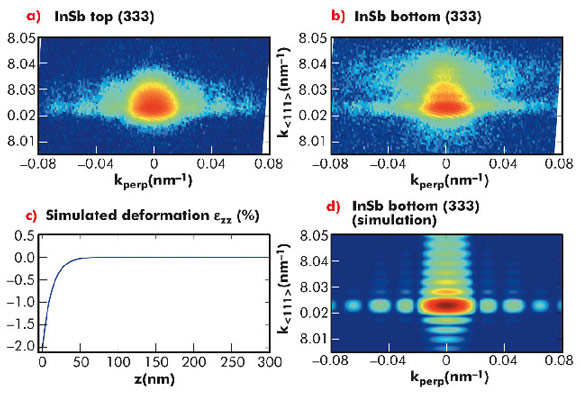- Home
- Users & Science
- Scientific Documentation
- ESRF Highlights
- ESRF Highlights 2010
- Structure of materials
- X-ray nanobeam imaging of InSb/InP nanowire interface
X-ray nanobeam imaging of InSb/InP nanowire interface
Nanostructures have been developed during the past 15 years with the goal of achieving smaller sizes, as well as exploiting confinement effects for electronic and photonic applications. These objects have called for the development of new X-ray techniques using focussing optics: Fresnel zone plates (FZP), Kirkpatrick-Baez mirrors and compound refractive lenses, yielding an intense X-ray beam with a flux between 102 and 104 photons nm-2 s-1. Such intense nanobeams allow Bragg diffraction on single objects smaller than 100 nm [1], from which the deformation and strain of the structure can be recovered [2].
In this study we report on the structure of heterogeneous InSb/InP nanowires (Figure 24) grown from Au seed particles with 30 nm diameter on InP(111)B substrates using metal-organic vapour phase epitaxy. To study the InSb/InP interface, we used beamline ID01 with a coherent 8 keV FZP-focussed X-ray beam, of dimensions 300 (vertical) x 500 (horizontal) nm2 (FWHM), which allowed different sections of the nanowire to be selected for diffraction (the total length of the InSb part is ~0.68 µm).
Figure 25 shows the diffraction patterns around the (333) reflection, recorded a) near the top of the InSb section, and b) close to the InSb/InP interface. In the latter image, asymmetric fringes appear in the vertical direction. To reproduce these fringes, we simulated the bottom of the InSb nanowire strain as a simple exponential decrease εzz = εzz0e–z/Δ (Figure 25c). Since the precise relaxation law could not be predicted (the relaxation due to the 10.3% lattice mismatch occurs mainly through dislocations and radial relaxation), we tried several values for Δ, with Δ = 10 nm and εzz0 = -2% giving the best agreement with the experimental pattern.
 |
|
Fig. 24: Nanowire heterostructure, with InSb at the top (ø 60 nm) and InP at the bottom (ø 30 nm), grown along the [111] direction. The X-ray beam focussed by a Fresnel zone plate has a 300 nm vertical size, and is able to probe different parts of the nanowire. |
The simulated scattering (Figure 25d) reproduces well the fringes, which are due to the combination of the height of the wire selected by the beam (the fringes period) and the deformation (the asymmetric intensity). The shorter d111-spacing at the bottom of InSb (relative to bulk InSb) is the signature of the interdiffusion during the deposition, with an InSbxP1–x chemical composition varying in the first 10–20 nm of InSb.
In summary, coherent X-ray nanobeams can now be used to study single, nanometre-sized objects, and to record diffraction at different positions inside these objects. This is an important milestone for the study of semiconductor nano-structures: in these heterogeneous objects, inhomogeneous strain fields have an essential influence on the physical properties, and they can now be measured on synchrotron beamlines thanks to nanofocussing optics.
Principal publication and authors
V. Favre-Nicolin (a,b), F. Mastropietro (a,c), J. Eymery (a), D. Camacho (a), Y.M. Niquet (a), B.M. Borg (d), M.E. Messing (d), L.-E. Wernersson (d), R.E. Algra (e,f,g), E.P.A.M. Bakkers (f), T.H. Metzger (c), R. Harder (h) and I.K. Robinson (i,j), New J. Phys. 12, 035013 (2010).
(a) CEA-UJF, INAC, SP2M, Grenoble (France)
(b) Université Joseph Fourier, Grenoble (France)
(c) ESRF
(d) Department of Solid State Physics, Lund University (Sweden)
(e) Materials innovation institute (M2i), Delft (The Netherlands)
(f) Philips Research Lab., Eindhoven (The Netherlands)
(g) IMM, Solid State Chemistry, Radboud University Nijmegen (The Netherlands)
(h) Argonne National Lab., Argonne, Illinois (USA)
(i) London Centre for Nanotechnology, University College (UK)
(j) Diamond Light Source, Harwell Campus (UK)
References
[1] V. Favre-Nicolin, J. Eymery, R.K. Koster and P. Gentile, Phys. Rev. B79, 195401 (2009).
[2] I. Robinson and R. Harder, Nat. Mater. 8, 291–8 (2009).




